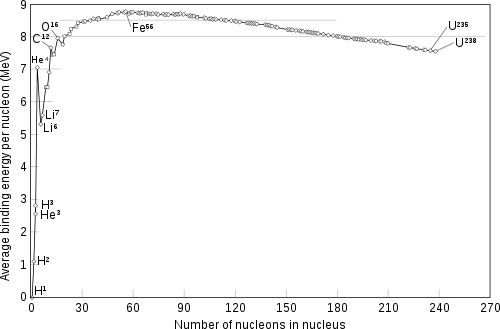Silicon-burning process
In astrophysics, silicon burning is a very brief[1] sequence of nuclear fusion reactions that occur in massive stars with a minimum of about 8–11 solar masses. Silicon burning is the final stage of fusion for massive stars that have run out of the fuels that power them for their long lives in the main sequence on the Hertzsprung–Russell diagram. It follows the previous stages of hydrogen, helium, carbon, neon and oxygen burning processes.
Silicon burning begins when gravitational contraction raises the star's core temperature to 2.7–3.5 billion kelvin (GK). The exact temperature depends on mass. When a star has completed the silicon-burning phase, no further fusion is possible. The star catastrophically collapses and may explode in what is known as a Type II supernova.
Nuclear fusion sequence and silicon photodisintegration
After a star completes the oxygen-burning process, its core is composed primarily of silicon and sulfur.[2][3] If it has sufficiently high mass, it further contracts until its core reaches temperatures in the range of 2.7–3.5 GK (230–300 keV). At these temperatures, silicon and other elements can photodisintegrate, emitting a proton or an alpha particle.[2] Silicon burning proceeds by photodisintegration rearrangement,[4] which creates new elements by adding one of these freed alpha particles[2] (the equivalent of a helium nucleus) per capture step in the following sequence (photoejection of alphas not shown):
28
14Si
+ 4
2He
→ 32
16S32
16S
+ 4
2He
→ 36
18Ar36
18Ar
+ 4
2He
→ 40
20Ca40
20Ca
+ 4
2He
→ 44
22Ti44
22Ti
+ 4
2He
→ 48
24Cr48
24Cr
+ 4
2He
→ 52
26Fe52
26Fe
+ 4
2He
→ 56
28Ni56
28Ni
+ 4
2He
→ 60
30Zn[nb 1]
The silicon-burning sequence lasts about one day before being struck by the shock wave that was launched by the core collapse. Burning then becomes much more rapid at the elevated temperature and stops only when the rearrangement chain has been converted to nickel-56 or is stopped by supernova ejection and cooling. The star can no longer release energy via nuclear fusion because a nucleus with 56 nucleons has the lowest mass per nucleon of all the elements in the alpha process sequence. Only minutes are available for the nickel-56 to decay within the core of a massive star, and only seconds if in the ejecta. The star has run out of nuclear fuel and within minutes its core begins to contract.
During this phase of the contraction, the potential energy of gravitational contraction heats the interior to 5 GK (430 keV) and this opposes and delays the contraction. However, since no additional heat energy can be generated via new fusion reactions, the final unopposed contraction rapidly accelerates into a collapse lasting only a few seconds. The central portion of the star is now crushed into either a neutron star or, if the star is massive enough, a black hole. The outer layers of the star are blown off in an explosion known as a Type II supernova that lasts days to months. The supernova explosion releases a large burst of neutrons, which may synthesize in about one second roughly half of the supply of elements in the universe that are heavier than iron, via a rapid neutron-capture sequence known as the r-process (where the "r" stands for "rapid" neutron capture).
Binding energy

The graph above shows the binding energy per nucleon of various elements. As can be seen, light elements such as hydrogen release large amounts of energy (a big increase in binding energy) when combined to form heavier elements—the process of fusion. Conversely, heavy elements such as uranium release energy when broken into lighter elements—the process of nuclear fission. In stars, rapid nucleosynthesis proceeds by adding helium nuclei (alpha particles) to heavier nuclei. Although nuclei with 58 (iron-58) and 62 (nickel-62) nucleons have the very highest binding energy per nucleon, converting nickel-56 (14 alphas) to the next element, zinc-60 (15 alphas), is a decrease in binding energy per nucleon and actually consumes energy rather than releasing any. Accordingly, nickel-56 is the last fusion product produced in the core of a high-mass star. Decay of nickel-56 explains the large amount of iron-56 seen in metallic meteorites and the cores of rocky planets.
See also
Notes
- Energy is produced in the isolated fusion reaction of nickel-56 with helium-4, but production of the latter (by photodisintegration of heavier nuclei) is costly, and consumes energy, causing alpha buildup of nickel to be shut off due to the essential fact that nickel-56 has nucleon binding energy less zinc-60.
References
- Woosley, S.; Janka, T. (2006). "The physics of core collapse supernovae". Nature Physics. 1 (3): 147–154. arXiv:astro-ph/0601261. Bibcode:2005NatPh...1..147W. CiteSeerX 10.1.1.336.2176. doi:10.1038/nphys172.
- Clayton, Donald D. (1983). Principles of Stellar Evolution and Nucleosynthesis. University of Chicago Press. pp. 519–524. ISBN 9780226109534.
- Woosley SE, Arnett WD, Clayton DD, "Hydrostatic oxygen burning in stars II. oxygen burning at balanced power", Astrophys. J. 175, 731 (1972)
- Donald D. Clayton, Principles of stellar evolution and nucleosynthesis, Chapter 7 (University of Chicago Press 1983)
External links
- Stellar Evolution: The Life and Death of Our Luminous Neighbors, by Arthur Holland and Mark Williams of the University of Michigan
- The Evolution and Death of Stars, by Ian Short
- Origin of Heavy Elements, by Tufts University
- Chapter 21: Stellar Explosions, by G. Hermann
- Arnett, W. D., Advanced evolution of massive stars. VII – Silicon burning / Astrophysical Journal Supplement Series, vol. 35, Oct. 1977, p. 145–159.
- Hix, W. Raphael; Thielemann, Friedrich-Karl (1 April 1996). "Silicon Burning. I. Neutronization and the Physics of Quasi-Equilibrium". The Astrophysical Journal. 460: 869. arXiv:astro-ph/9511088v1. Bibcode:1996ApJ...460..869H. doi:10.1086/177016. Retrieved 29 July 2015.